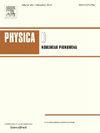Spatiotemporal patterns in a delay-induced infectious disease model with superdiffusion
IF 2.7
3区 数学
Q1 MATHEMATICS, APPLIED
引用次数: 0
Abstract
Typically, human mobility patterns exhibit distinct large-scale and long-distance features, rendering the standard Brownian motion-based reaction–diffusion modeling inadequate. Consequently, this paper introduces a novel reaction-superdiffusion infectious disease model to delve into the long-distance geographical dissemination of infectious diseases. Theoretically, we have determined the threshold conditions for Turing instability without delay, formulated the amplitude equations characterizing Turing patterns, and devised stability assessment methodologies. Additionally, we have delved into the mechanisms of Hopf and Turing–Hopf bifurcations triggered by delay, utilizing normal form theory and the center manifold theorem to scrutinize the stability and directionality of the resulting periodic solutions. The numerical simulations robustly corroborate the theoretical findings. Notably, while the superdiffusion exponent minimally impacts the pattern shape for Turing patterns, a decrement in its value conspicuously augments the area and isolation of the patches. Conversely, in wave patterns, both the superdiffusion exponent and delay act in concert to modulate the pattern’s morphological evolution. Interestingly, when the selected parameters lie within the Turing–Hopf instability region, we observe spatio-temporal heterogeneous patterns distinct from Turing and spiral patterns. Our findings enrich the existing results.
具有超扩散的延迟感染性疾病模型的时空模式
通常,人类移动模式表现出明显的大规模和远距离特征,使得标准的基于布朗运动的反应扩散模型不充分。因此,本文引入了一种新的反应-超扩散传染病模型来研究传染病的远距离地理传播。在理论上,我们确定了无延迟图灵不稳定性的阈值条件,建立了图灵模式的振幅方程,设计了稳定性评估方法。此外,我们还深入研究了由延迟引发的Hopf和图灵- Hopf分岔的机制,利用范式理论和中心流形定理来仔细检查所得到的周期解的稳定性和方向性。数值模拟有力地证实了理论结果。值得注意的是,虽然超扩散指数对图灵图案的图案形状影响最小,但其值的递减显著增加了斑块的面积和隔离度。相反,在波浪模式中,超扩散指数和延迟都协同作用来调节模式的形态演变。有趣的是,当所选参数位于图灵-霍普夫不稳定区域时,我们观察到不同于图灵和螺旋模式的时空异质性模式。我们的发现丰富了现有的结果。
本文章由计算机程序翻译,如有差异,请以英文原文为准。
求助全文
约1分钟内获得全文
求助全文
来源期刊

Physica D: Nonlinear Phenomena
物理-物理:数学物理
CiteScore
7.30
自引率
7.50%
发文量
213
审稿时长
65 days
期刊介绍:
Physica D (Nonlinear Phenomena) publishes research and review articles reporting on experimental and theoretical works, techniques and ideas that advance the understanding of nonlinear phenomena. Topics encompass wave motion in physical, chemical and biological systems; physical or biological phenomena governed by nonlinear field equations, including hydrodynamics and turbulence; pattern formation and cooperative phenomena; instability, bifurcations, chaos, and space-time disorder; integrable/Hamiltonian systems; asymptotic analysis and, more generally, mathematical methods for nonlinear systems.
 求助内容:
求助内容: 应助结果提醒方式:
应助结果提醒方式:


